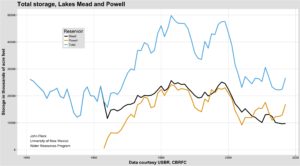Talking this week to members of the Colorado River water governance brain trust at the Family Farm Alliance‘s annual gathering in Las Vegas, there was a weird vibe about the big snowpack building in the Rockies.
My quick take based on the February USBR modeling plus the latest forecast info from the CBRFC Lake Powell could pick up 4 million acre feet this year, and with a likely release of some bonus water through the Grand Canyon for downstream users, Lake Mead could stabilize.
These numbers have substantially reduced the pressure to finalize a “Drought Contingency Plan” to reduce use of Lake Mead water in the Lower Basin and prepare for possible Powell shortfalls in the Upper Basin. All that extra water and breathing room must be a good thing, right? The weird thing was the tenor of some of the resulting conversations. The DCP deal is important, and it was really close. Now, to some folks, it’s looking less urgent. With the pressure reduced, some of the key players seem to be using the opportunity to drive harder bargains (or dig their heels in to avoid hard bargaining) – on the complex shortage distributions within Arizona, for example, and on the Salton Sea.
For those trying to get the damn deal done, the big snowpack is a setback.
So it’s worth reminding ourselves where we’re at. From the perspective of the last few years, a 4 million acre feet bump is great news. But as the graph above makes clear, we’ll still end up the water year down 20 million acre feet from the start of the 21st century. We’re along way from being out of the hole.


Human nature is starting to kick-in. We don’t think of the roof till it rains, we don’t think of conservation and the DCP when it does.
Tell me you didn’t see this one coming.